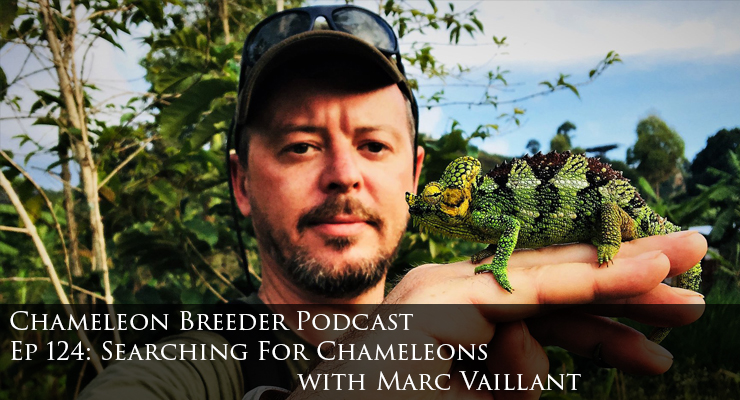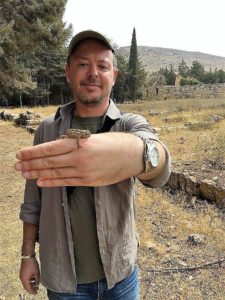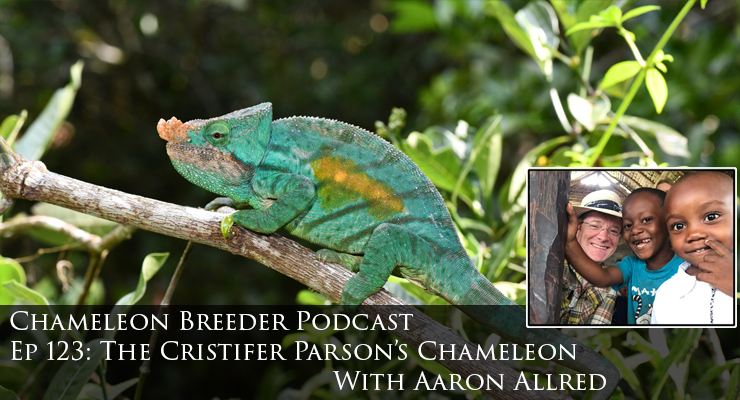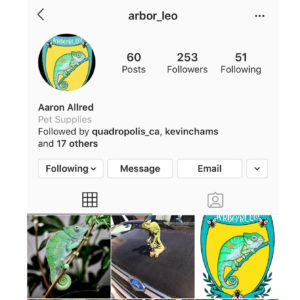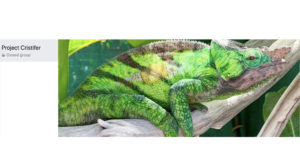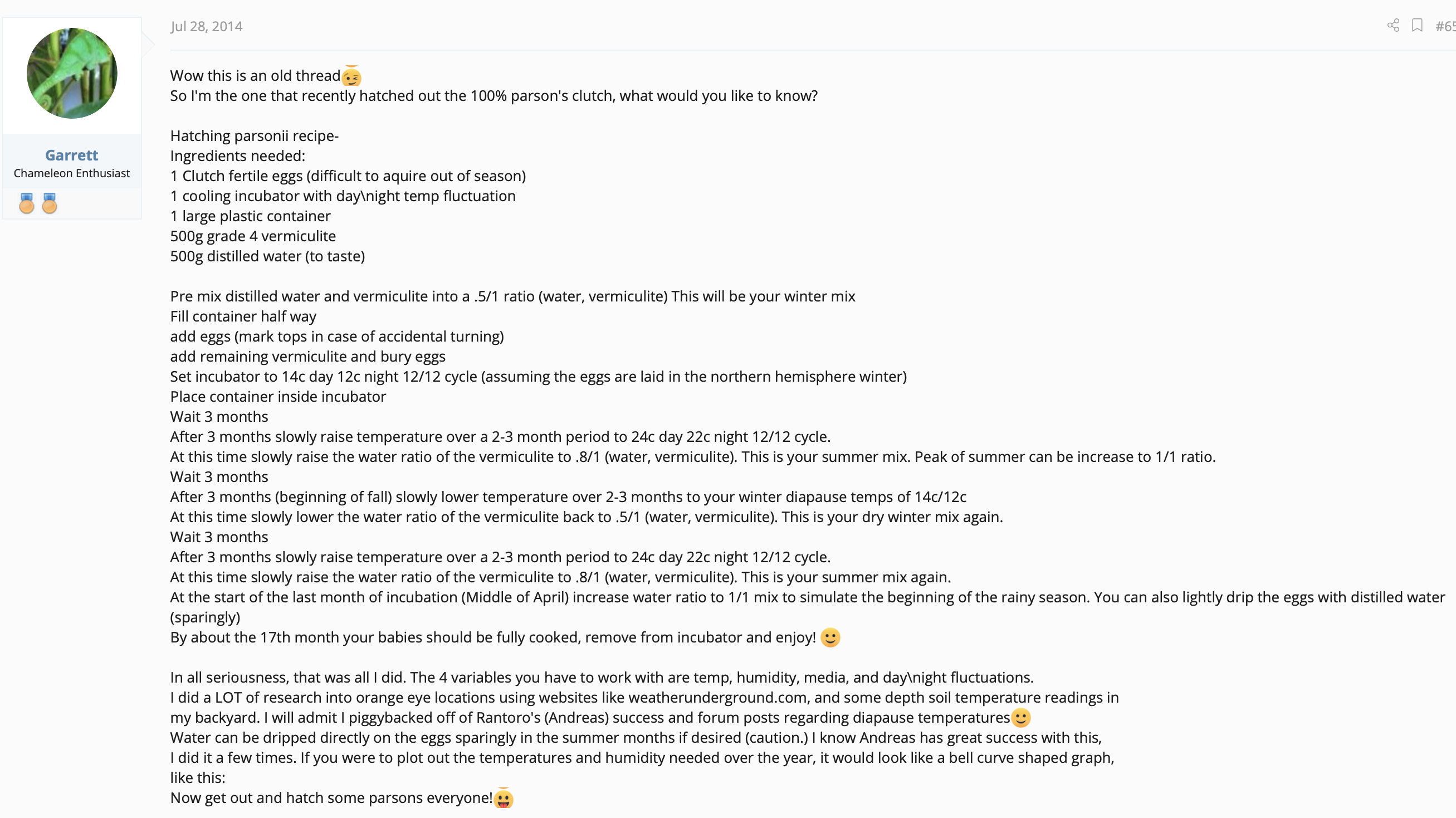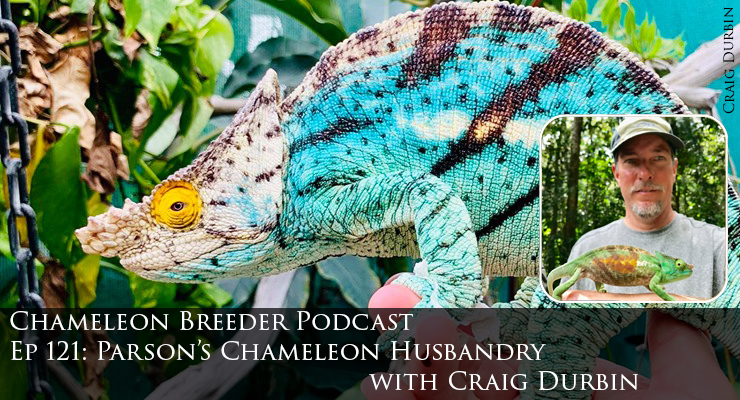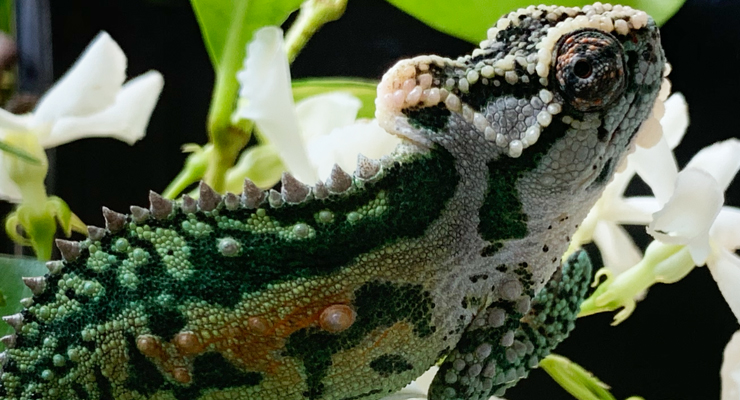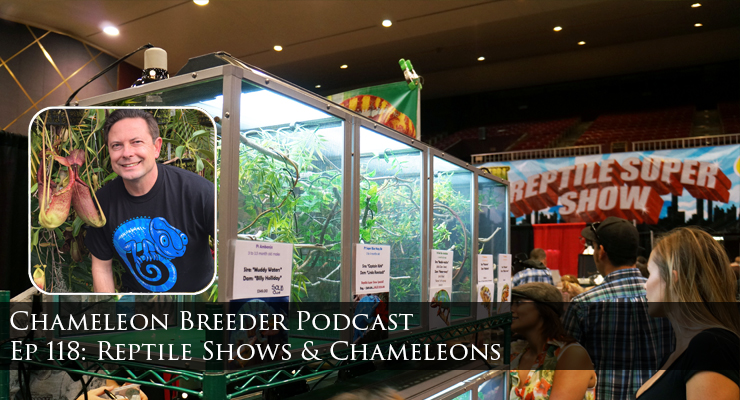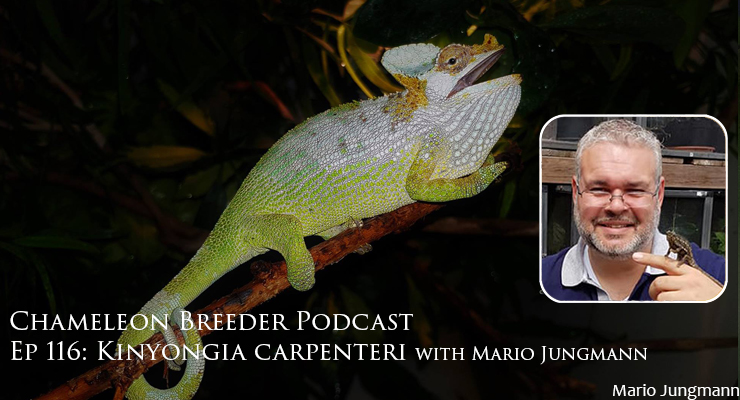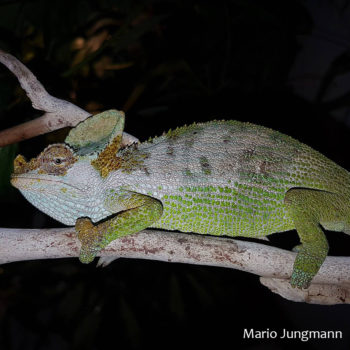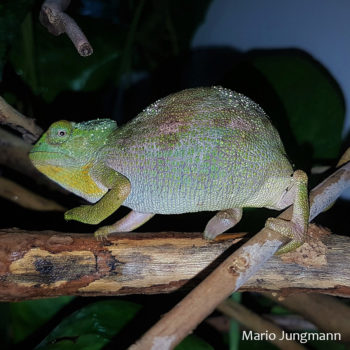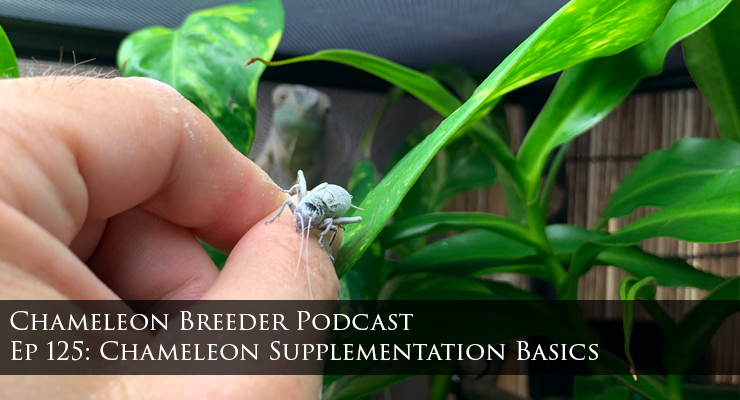
Transcript (more or Less)
Supplementation is a complicated subject. We still don’t even understand what humans need for nutrition, much less what a chameleon needs. Most of what we do with chameleons comes from trial and error. The more trials, the more errors we can weed out. Today I start a series on the basics of supplementation so we can all understand what we are trying to do with all those powders.
Nutrition is a rat’s nest of interactions between vitamins, minerals, hormones, and light, temperature, and stress. Our chameleons take in a variety of invertebrates and vertebrates that are composed of different nutrients both in body make-up and in their gut. Dust and pollen come along with these insects and through drinking. UVB and heat energies are absorbed. And water makes it all run. It is our job to provide all of this to our chameleon. With what science already has discovered we have a fairly good idea of what elements need to be presented to the chameleon. We can have this all available and let the chameleon decide what he wants and how much! It a ll sounds pretty easy! The good news is that, with a little thought, much of it is as easy as that. Give them a heat lamp and a good enough UVB source and they will regulate that intake. The bad news is that we still don’t know how to make our feeder items properly nutritious. See, it isn’t about just throwing all the vitamins and minerals we can into a powder and making them eat it. There is a need for balance and, in some very important cases, a danger in giving too much. And with very little study to go off of, we hobbyists are left to figure it out.
One way we make up for nutritional deficiencies in our feede r insects is to add supplement powders to the feeder insects. After we gutload them and make them and their gut as nutritious as possible, we add a layer of supplement powder to the outside of the cricket, or whatever insect we are using. The idea is that this supplement compensates for the lack or imbalance of nutrients. Let’s take the most common example. Crickets are the most common feeder insect in the US. This is because they are relatively easy to breed commercially. Luckily, they have been proven to be sufficient to power our chameleons. But crickets have way too much phosphorus compared to the calcium they offer. The latest science pins it at calcium needing to be twice the level of phosphorus for it to be beneficial and not detrimental. Because, just so you know what kind of tightrope over lava we are walking, too much is dangerous. Too little is dangerous. Off balance is dangerous. There are consequences to getting it wrong either way. So we need to add calcium to the crickets to counteract how much phosphorus they naturally provide. This is supplementation.
In the upcoming episodes we will be exploring various aspects of supplementation. I’ll share what we know and what we don’t know. It will be a winding road, but you all have done a pretty good job at sticking with me through all the curves of this fascinating, but sometimes crazy chameleon world. So strap in and let’s figure out where we stand on supplementation.
In this first installment I want to lay down the foundation from which we will go forward. I want to lay down the methods you can use to intelligently analyze a supplementation routine. Once this foundation is laid down we can effectively discuss the supplements out there and the routines to use them.
First, let’s lay out our major considerations when dealing with supplements. And I need to caution you on two things. First, there are many moving parts. I am going to do my best to simplify and generalize without going so far that the information is watered down. Hang on and let’s see how I do. My job here is to bring all the pieces into a coherent picture and distill it all into an understandable concept. To do this with nutrition will be my greatest challenge. Second, this topic is even more complex than can be explained and, unfortunately, more complex than we understand with today’s science. So please take this episode as a first most basic step. My goal for this episode is that you understand enough about nutrition that you can make intelligent decisions about your supplementation product and routine. Asking more experienced people for advice is helpful and where you should start, but nothing can replace the effectiveness of understanding it yourself and making your own decisions. We have done many episodes on nutrition so this is looking at it from another perspective. And, we will continue to explore this subject for the entire life of this podcast. This is a growing science and understanding will change! Now, as I said, in this episode I am going to be distilling things down into basics. We cannot ignore that all the items I do not talk about today also are critical for everything to work, but we need to start somewhere.
As we look at each of the components I will make a point of explaining how the chameleon gets this in the wild and what the danger of overdose is. These two items are related as if we provide the element as the chameleon would normally get it in the wild then we are able to use the naturally occurring checks and balances within the chameleon’s body to prevent overdose. If we provide the element in a different manner and we bypass the normal checks and balances within the chameleon’s body then we must be very careful not to give too much or we can kill our chameleon. It is that serious. In this overview, we will look at three main elements: Calcium, Vitamin D3, and Vitamin A. We will then take a look at the supplements available and do some real world analysis on what they offer us.
So, let’s jump in and start with the most important components to supplementation. The first is calcium.
Calciumis a building block for our bones and critical for proper organ function. It is so important that there is no debate as to using it as a supplement. Calcium is a curious mineral as it is so plentiful all around, but we are not sure how chameleons get their calcium. Insects are usually poor sources of calcium and vertebrates with those calcium skeletons are rare prey items. Whatever the source of calcium, babies need a lot of it and they provide the biggest challenge to explain how they get it. Possibilities include certain rare insect species and invertebrates which do have calcium, licking dust infused water from leaves, and eating insects which have plants that contain calcium in their gut. Whatever the path, one thing that is important to this discussion is that we know that calcium in the wild is ingested orally. So this means that our oral supplementation of calcium is giving it to them in a way that they were designed to take it in. And calcium overdose from calcium itself has not been a problem for us. I am sure we could give too much of anything, but our main problem with causing hypercalcaemia (which is too much calcium in the blood stream) is with too much Vitamin D3 which facilitates the absorbtion of calcium from the gut. Otherwise unused calcium is just flushed out of the system. We hear about how we humans can takes too much calcium carbonate (aka Tums), but I have not heard of creating hypercalcaemia in chameleons with just plain calcium. The take away here is that calcium can be dusted every feeding without it being a health issue. There are other things we will worry about.
Now, there is a balance we must be familiar with. And that is with phosphorus. This is also an important element in building our, and our chameleons’, bones. The thing is that calcium and phosphorus must be in a certain balance. You need to have a two parts calcium to one part phosphorus balance. Crickets, and many of our feeder insects, have a tiny amount of calcium, but a relatively huge amount of phosphorus. So our feeder insects are naturally high in phosphorus. How do we balance this out? We add calcium powder to the phosphorus high feeder. This is why calcium is supplemented every feeding in every routine I have done or have encountered. And it is important to understand this when shopping for a supplement. In some supplements, they brag about having the 2:1 calcium to phosphorus ratio. Sound good? A perfectly balanced supplement! Well, no, because if you put a perfectly balanced supplement on an imperfectly balanced feeder insect you can never get the proper balance. This is why we need to be aware of what is important. And, don’t worry, at the end of this episode I will go over some major brands and we will discuss the pros and cons of each. We’ll tie it all together in the end.
So, do we need to supplement the rare feeder that has calcium, such as the Black Soldier Fly larva? No, you do not have the supplement calcium on BSF larva as they, as far as the studies we have available, already are balanced enough. It will not hurt anything to add more calcium to them, but I don’t for a totally different reason. The more powder we put on our feeders the more we throw off their hydration value. Chameleons get a significant amount of hydration from the food they eat and we throw that off with all this powder that they have to then use up their water stores to rehydrate. This is not a real problem to worry about because, unlike the wild, we provide plenty of water on a daily basis. But, it never hurts to give their body what they expect. I do not know how much value this actually brings, but if my chameleons end up living twice as long I am going to attribute it to this natural hydration and start my own chameleon husbandry cult. Stay tuned for membership information.
Any discussion about calcium quickly becomes a discussion about Vitamin D3.
Vitamin D3is the main component that allows the body to extract calcium from the gut and bring it into the body. There the calcium is directed to go where it needs to go which is mostly to the bones where it is used for structure and is stored to be released as needed for proper organ function. Vitamin D3 is created in the chameleon’s body. The body uses the energy from a very specific narrow wavelength band of ultraviolet light and through a process which goes from the skin to the liver to the kidney, creates the end vitamin D3 product.
Vitamin D3 is a fat soluble vitamin which means it is stored in the body. Here is where it gets important. Vitamin D3 is manufactured by the body and stored. The body measures the levels of D3 and turns on and off manufacturing to maintain a certain level. The problem is that there is no mechanism for restricting the amount of D3 absorbed from the gut. This is not a problem in nature because there is very little dietary vitamin D3 around to be eaten. There are small amounts here and there, but not enough in the normal chameleon diet to require evolution to build a defense mechanism from dietary D3. Now, you see where this is going. By us giving dietary D3 we bypass the natural checks and balances and the chameleon’s body will store vitamin D3 into overdose. So if we give supplements that have dietary D3 then we are responsible for providing a safe amount. Except no one knows what a safe amount is for each species. And if we did, our delivery mechanism of powder on an insect which will fall off with a function of time is grossly inaccurate. That said, Vitamin D3 has been used in supplements for decades and has been used effectively and safely. It was dietary D3 that allowed indoor chameleon breeding before the advent of the UVB light.
Fat soluble vitamins such as D3 and A, which we will get to soon, can, when in excess, cause a condition known as edema. This is where the body reacts to the imbalance by retaining excess fluid. This is often seen as a bulging fluid collar around the neck. We got this a lot in montane chameleons such as Jackson’s Chameleons, any of the high altitude Cameroon species, johnstoni, etc.. Panthers and veileds seemed to have more of a resistance to this condition. So the dietary D3 which allowed indoor keeping of chameleons was causing issues in some species. The great news with Vitamin D3 is that we have enough UVB technology that we do not have to play that guessing game any more. With the powerful UVB lamps and the Solarmeter 6.5 to measure the effective UVB levels we can now tune our environments to where full vitamin D3 requirements can go through the natural channels. So you may ask, why do most supplementation routines we see include dietary D3 in them? Two reasons. 1) most people do not have solarmeters to dial in the levels so there is a level of nervousness and 2) for all of our collective bravado talking on UVB, there seems to be a lack of faith that it actually works and people want that safety net. To that I say, go ahead and have the safety net. Supplementation once or twice or four times a week according to species and amount of D3 in your supplement..I also want to add that you can get rid of D3 in your supplementation. People that provide a UV Index of at least 3 at the basking branch can do away with D3 in their diet . I know people will be nervous to try this without the D3 safety net. But I am not the only one who has done this successfully. You can too. It does take a little effort because you have to make sure that you are getting at least UVI 3 at the basking branch so there is some fine tuning that needs to be done. Chameleon keepers will recognize this as something we have to do with just about every other aspect of husbandry so this isn’t anything new. And this is where we should all be.
Now, to all you people out there giving advice, it probably is a good idea to keep a dose of a supplement with D3 in there one or two times a month just to make sure bases are covered. If you are talking to a beginner you need to have as simple of a routine as possible with the most margin for error. If you are only telling them the bulb strength to get like 5.0 or 12% and aren’t guiding them further then a safety net is a good thing. We’ll talk about specifics per species in a little bit. We have to take into account the amount of D3 as well.
And for those keepers listening who are invested in the art of chameleon husbandry enough that you have a Solarmeter 6.5 and are monitoring the UVB levels, I invite you to get a range between UVI 3 and 6 and back off of the vitamin D3. Try it. It works. And this removes an unnatural part of your husbandry. If you are going to go through all the expense and effort to set up a solid UVB system, you may as well get the full intended benefit from it! The ability for us to emerge out of giving D3 orally and into providing it through the natural means that the body expects is a victory for captive husbandry. Let’s take full advantage of it.
Vitamin A:
Our final member of the big three is Vitamin A. Vitamin A is, by far, the most troublesome of our supplement components. And this will take a little explanation. You probably have heard of something called pre-formed vitamin A. This is vitamin A in what we call the Retinol form and can be used by the body to create retinaldehyde and retinoic acid which contribute to eye and skin health. Pro-vitamin A are things called carotenoids. The most famous of these being Beta Carotene. This is what gives carrots their orange color. And our bodies use Carotenoids to generate retinol. This is great for humans. We can eat pre-formed or pro-vitamin A. The danger with pre-formed vitamin A, or getting retinol from animal organs is that there is no checks and balances to ensure it stays at a safe level. Pro-vitamin A, though – the carotenoids, must be transformed by the body and the body will only do that when it is necessary to replenish the stores. Yes, Vitamin A, like D3, is a fat soluble vitamin so it takes a front seat on our watch list here.
Vitamin A, or retinol, is rare in insects as far as we know at this time. So it is assumed that insectivores get their vitamin A from ingesting insects that have eaten plants and the carotenoids within. And then the carotenoids are transformed into vitamin A and all is good. But, unfortunately, it cannot be that easy. In a 2002 study, Dr. Dierenfeld, with help from Dr. Ferguson who is well known in chameleon circles attempted to figure out the relationship of carotenoids and vitamin A in panther chameleons. The end result was unexpected that dietary beta carotene did not seem to be converted into vitamin A. This left big question marks as to how chameleons got their vitamin A. In a subsequent 2003 roundtable discussion printed in the Journal of Herpetological Medicine and Surgery, Dr. Ferguson hypothesized that female panther chameleons could be driven to eat vertebrate lizards for the preformed vitamin A to provide that within the eggs to give the babies enough vitamin A until they get big enough to eat vertebrates on their own. He emphasized that there is more investigation that needs to be made to determine whether and under what conditions chameleons can “do the vertebrate thing” and convert carotenoids to useable vitamin A.
Although vertebrate ingestion is certainly possible for panther chameleons and larger chameleon species that hypothesis gets improbable for the smaller species of chameleons. That does not mean that Parson’s Chameleons and pygmy chameleons do the same conversion so there is room for different methods across the different species. Does the fact that we know next to nothing about such a basic part of chameleon nutrition make you wonder how we are bumbling through this whole thing? Well, it is certainly an adventure!
Now, it is good to be aware that the 2002 Dierenfeld study which showed that panther chameleons did not convert beta carotene has been oversimplified across the veterinary community to the effect that allchameleons do not convert anycarotenoids and require preformed Vitamin A. It is true that this statement is valid within veterinary circles. The job of a veterinarian is not to extract the secrets of the universe. They need to get your chameleon back up to health. Up until recently, the only carotenoid used in supplements has been beta carotene. So, practically speaking, there would be no supplement available to their clients that would provide anything that would convert to vitamin A. With all the tools available to bring this chameleon back to health and maintain health, pre-formed vitamin A is the only thing that has been proven to work. So, until someone somewhere proves that there is a more effective method to cure and prevent the effects of vitamin A deficiency (this is called hypo-vitaminosis A) the veterinary community will continue to advise their members that chameleons cannot convert carotenoids.
That is what works for their purposes. We in the chameleon community have different purposes. We have more of a long term vision of striving to provide as natural of a husbandry as possible. Dietary pre-formed A is not, as far as we know, natural for chameleons. And this is more than just a high ideal we strive for. Vitamin A is a fat soluble vitamin and is dangerous and deadly in overdose. By switching to the correct carotenoids we can use our chameleons’ internal system to ensure that they always have the exact level they need. No matter how much carotenoids we give them it won’t matter because they will shut off production when they have enough. Cracking this mystery has the direct benefit of healthier chameleons. Just as we have worked so hard to get vitamin D3 out of the diet, so we need to continue to work to get preformed vitamin A out of the diet. But, we are not there yet. So preformed vitamin A is something we still need to discuss on this episode.
Though I do want to say there is work done and there are successes on this front. We do know that other herps convert other carotenoids so it is not unrealistic to assume that chameleons would do so as well. It could be that it takes a combination, or balance, of carotenoids to convert. I have raised veiled chameleons up to successful reproduction using only the Arcadia EarthPro-A supplementation and gutloading. So there was no pre-formed vitamin A supplementation. Mario Jungmann has his complete long term breeding facility thriving on gutloaded insects and a mix of calcium and bee pollen. So it can be done. I am personally experimenting across different species using the Arcadia EarthPro-A, which specifically includes a wide range of carotenoids for vitamin A production. But you can’t judge a supplementation routine until you test it over multiple generations. And then you have tested it for only that species. And then individuals within clutches will respond differently so you need multiple generations to really get a feel for what is going on. So I will report what is working for me, but I am not to the point where I can speak with the confidence that someone like Ed Kammer of Kammerflage Kreations with eight years of experience testing one routine with one species under controlled conditions can speak. But that is to be expected. Ed needs as bullet proof a system as possible for beginners to be successful. He is not interested in great ideas. He needs generations of proof. He will not get behind a supplementation routine until it has at least three years and two generations of success behind it. Me? I am working on the cutting edge where there is an enormous amount of ambiguity. Both have their place and their value. The veterinary community, Kammerflage Kreations, and this podcast. We all have different reasons that drive what we do. So when you go out into the social media jungle, realize that there are many ways that work for different purposes. Me being frustrated that the vet community gave this subject the broadbrush does not mean they are wrong to do what they did. It is saving chameleons lives and that is what they care about. That is their job! The Kammerflage routine that includes D3 and A has been refined over years and chameleon generations to provide the simplest way to raise healthy panther chameleons. My drive to get D3 and A out of our supplementations does not make that routine wrong. It is the most tested and proven out method we in the community have. And if I hit dead ends in my quest to rid us of D3 and A that does not mean I shouldn’t do what I am doing. All these approaches have their place in our community. And they are not exclusive. Ed Kammer and I just had a conversation about how we can reduce our dependence on preformed vitamin A. He is just as interested in giving better nutrition as I am. But I can tell you that whatever I/the community/whomever comes up with as a true step forward will go through two generations and three years of testing before he will publicly get behind it. And that is how it should be. I and the people who are dedicated to naturalistic husbandry are on the front lines testing these things out. We have the experience necessary to fix the plane while we are flying it. Ed is working with people who are just starting out with chameleons and need the sure thing. Do you want adventure and do you feel comfortable figuring things out? Well, you have come to the right place! Do you want security and the sure thing? Meet my friend Ed. We are all part of the same effort. And I don’t want to make it seem like I am the vanguard of this naturalistic diet movement. I talk a lot. I mean, that is my job here. But people like Arcadia’s John Courteney-smith have dedicated their professional lives to pushing us forward. It is no coincidence that John has been a frequent guest here. Our missions are closely aligned. The thing with John is, he is distracted by having to consider all the lesser reptiles. I am lucky that I am able to concentrate on chameleons – the purest manifestation of awesomeness.
Magnesium. Now I want to bring up one more part of this. And that is magnesium. Everything is complex. And there are many other interactions that are going on. So much so that your head would spin and I would break down sobbing into my keyboard trying to chart it all out. This is not simple. I’ll bring up one example and that is of magnesium. This little heard from mineral tells the calcium where to go in the body. Without the right amount of magnesium you get calcium deposits in strange places. So it is very difficult to determine what the problem is without a bloodtest. Lack of one vitamin and overdose of another vitamin can have similar external effects. Do you see the danger of being so quick to diagnose vitamin overdose or deficiencies when you are not a vet? We have to be careful with what we do with a little bit of information.
So with that background, lets take a look at the field of supplements we have to wade through.
We start with calcium. This is the easiest. Just about every supplement manufacturer has plain calcium. The one thing you have to watch out for is that many manufacturers have two products. Calcium and Calcium with D3. Just make sure you are getting the right one for your purposes. Plain calcium is great for dusting every feeding because, we do not have to worry about overdose by giving calcium and we need to balance out the high levels of phosphorus in the most common feeder insects. So, not only is it safe, but it is necessary.
Now, while we are on the topic of every feeding supplementation I want to bring up bee pollen. Bee pollen has been a staple in the chameleon community forever. It is recognized as having an incredibly rich blend of nutrients that it is a chameleon super food. And, if you have ever seen how excited your chameleon is to snag a bee you can imagine that they ingest a great deal of bee pollen in the wild. You can use bee pollen as a gutload, but also as a supplement. It doesn’t stick by itself, but when you mix it with calcium it becomes a great powder. You have to crush it up. I put calcium and bee pollen in a mortar and crush it up with a pestel. My wife makes fun of me for not using premade powder, but I enjoy this connection with the ancient stone age chameleon keepers that crushed up their powder supplements for their chameleons. Never forget where you come from. Although, I admit to embracing my 21 century luxury and not grinding up limestone for calcium like they had to.
Though it does get easier than all this. The power I have been using for the last couple years is the Arcadia EarthPro-A. And since there are no fat soluble vitamins in this supplement I can safely use this every feeding with worrying about how much is going in. EarthPro-A has bee pollen and has been formulated to have a wide range of carotenoids. With the building blocks but none of the final form, it is safe to give every feeding. So that makes getting calcium and bee pollen in very easy. I’d like to clarify something. Arcadia EarthPro-A does not have preformed vitamin A. It has a wide variety of carotenoids that reptiles can use to convert to vitamin A. We’ll talk more about this when we talk about vitamin A because this is important.
Calcium is often included with other vitamins and minerals. If you are using supplements that have something in them besides calcium check for phosphorus. As we touched on before, calcium and phosphorus need to be in a 2:1 ratio. This is why we have to add calcium to crickets. But check the ingredients list to see if the supplement has phosphorus. Most d o not.The noteable exceptions are ZooMed’s Reptivite product and RepCal’s Herptivite. Repcal’s Herptivite goes the beta carotene route so the only use for us is calcium and there are much better alternatives so this will be the last you hear about Heptivite on this episode. The ZooMed Reptivite doing 2:1 calcium/phosphorus ratio is personally disappointing because Reptivite without D3 is one of only two commercially available supplements that has Vitamin A, but not Vitamin D3. As UVB has solved our need for D3, I’d like a solution for vitamin A. Since it pains me to accept the phosphorus hit I mix in some of my Arcadia EarthPro-A or just plain calcium. But more on that later. The point is to watch the label for phosphorus. We chameleon keepers don’t want that in our supplement because we have an excess of it already in most of our feeder insects . Though I suppose I need to include the caveat, if your feeder insects lack phosphorus then go ahead and look into a supplement with a 2:1 ratio. ZooMed’s Reptivite would be the first place I would look for this.
But now it is time to get to Vitamin D3. Vitamin D3 is easily found in supplements and it is added to calcium to provide the combination necessary for making the calcium useable. Obviously, I now run a D3 free household. I have supplements that have D3 in them for use only when I am experimenting, but I am for all practical purposes a D3 free Jurassic Park. If your adviser wants you to include D3 in your routine or you just want the safety net then you need to consider the amount of D3 you are giving. Excess D3 will cause problems including edema. And montane species such as Jackson’s chameleons are especially sensitive to these fat soluble vitamins. It appears that species such as panther chameleons, veiled chameleons, and carpet chameleons, can handle Repashy Calcium Plus every feeding. This means that they are given doses, if we can call it that, of 20k International Units/lb of D3 along with 200k IU/lb of Vitamin A every other day. This is from long term breeders keeping them under a variety of lights from T8 to T5.
And here is where we need to take a serious look at UVB. We know that UVB hits the skin, gets transformed, goes to the liver where it is changed some more, and then to the kidneys where it is changed again into the final form that is used in the body for the calcium absorption. If there is enough D3 in the system then no more is made. If we give dietary D3 we bypass this system and that is why we are working towards getting out of D3. But a question we also need to consider is whether the body reads the levels of dietary D3 and shuts down production if there is enough in the system regardless of where it comes from. This is a worthwhile question because if the body accepted the dietary D3 then, if you gave enough it wouldn’t matter what UVB light you are using. As long as there was less than “too much” D3 given dietarily you could have various levels of UVB and it wouldn’t result in overdose to have higher levels of UVB. It would just be more UVB that is being ignored by the body. Ed Kammer of Kammerflage Kreations tested giving Repashy Calcium Plus to chameleons under Reptisun 5.0 T8s and Reptisun 5.0 T5s, both in single bulb reflectors and noticed no change in outcome. One possible explanation is that the D3 levels in Calcium plus are sufficient or else the T8 light was enough to top it off. So going to a higher power UVB light had no effect because the body just ignored the more intense UVB. The significance of this is that you would have a certain safe area to work with as far as D3 supplementation and that we could take the Repashy Calcium Plus levels of 20k IU/lb every other day as safe. Now, this is not meant as me giving a revelation and putting an axiom down in stone. When we talk about levels we have to talk about how many feeders per feeding, how soon the feeders get eaten, and how densely dusted the feeders are. This is a discussion for those of you that want to dig in and figure this stuff out. The one take away from this is that we have an idea of the safe levels and if your D3 supplement is 20k IU/lb or less it should be okay for panthers/veileds/carpets, and like species.
Jackson’s Chameleons are a different story. They tend towards edema at those levels. For Jackson’s Chameleons, Repashy Calcium Plus LoD only has 8k IU/lb and has been shown to work with Jackson’s a couple times a month. This amount is tribal knowledge. A long time ago I used Repashy Calcium LoD with Jackson’s Chameleons that were outdoors. I would never do that now, but there is situation where I was learning. The chameleons were healthy and there was no edema. So this is where I am suspecting that higher UVB is not going to create a D3 overdose situation if dietary D3 levels are within the acceptable body level limits.
But please consider, if you are spending so much energy working the strong T5 lighting – especially if you are going to the higher powers of UVB like 12% or 10.0– consider just putting this whole mess behind you and going full natural D3.
Okay, who out there has their heads spinning trying to hold this all together? Well, it is nice to have company.
Is anyone out there wondering what an International Unit is? You will love this. It is a measure of biological activity. So the mass of an IU of vitamin A will be different than the mass of an IU of vitamin D3. Don’t even try to fully grasp it at this point. It really doesn’t matter what it means as long as every supplement manufacturer is using the same system. This way we can make experiments and we know the relative strengths. That is all that is really important to understand about International Units.
I do want to say for vitamin d3 that It is also important to keep track of vitamin A in the supplements. We know there is an interaction between D3 and A so this is a possible characteristic we need to keep an eye on. If we have too much vitamin A it might skew our test with vitamin D3. And then we couldn’t recreate it with a supplement that had only D3. Once again we take our supplements as a whole and test them as they are as a whole.
Vitamin A is even more mysterious, but easier in some ways. When planning out your supplementation schedule look at the ingredients list. Some manufacturers include beta carotene in their supplements and call it vitamin A. We chameleon people, with what we know now, can’t accept that. Noteable products with beta carotene instead of vitamin A are Rep-Cals Herptivite (oops, I said I wasn’t going to talk about that one again) and Exo-Terra’s Multi-vitamin. Although having beta carotene is not a bad thing in itself and some supplements such as Repashy’s Calcium Plus and Fluker’s Repta Vitamin have both beta carotene and vitamin A so you don’t have to throw something out because it has beta carotene.
The same considerations we went through with vitamin D3 apply here as well. The Repashy Calcium plus and the Calcium Plus LoD that we have tested with those species listed also have vitamin A so the limits established there can be used as a foundation for figuring out vitamin A levels.
If you are going for a Vitamin D3 free routine then finding a supplement for A without D3 is actually challenging. You have two commercially made powders. Reptivite without D3 and repashy Vitamin A. Reptivite without D3 gives 100k IU/lb compared to Calcium plus at 200k IU/lb and Calcium plus LoD at 80k IU/lb. So Reptivite is on the lower end of these widely tested Repashy products. The other supplement available is the Repashy Vitamin A plus. No D3, but this powder has 2 million IU/lb so that is quite the leap beyond the 200k IU/lb reference level. I did use the Repashy Vitamin A for a little while. I would dust one cricket in this vitamin A, make sure it was eaten, and then go on with the standard everyday Arcadia EarthPro. I am now trying the Reptivite and cursing under my breath that they included phosphorus. I’d like to do a control group of some babies with and some without vitamin A. My last test focused on D3 and A just happened to be part of it. I’d like to specifically show to myself that I can use the carotenoids in EarthPro-A and get rid of vitamin A in our supplements. Yes I did it once under controlled conditions with four veiled chameleons. That is a good indication, but I do want to repeat this for more individuals over a couple generations. Ed Kammer has pretty much set the standard for how a supplementation routine should be tested. I think we all ought to step up to the plate and do the same with our favorite routine before we get too emotionally invested in it.
Okay, dust settles. What should we do. Well, let’s summarize
Calcium? Dust every feeding. Plain calcium is pretty much the same across the manufacturers. Pick the bottle with your favorite color. Successful breeders, including me, include bee pollen with the every feeding dusting. You can make your own by mixing calcium and bee pollen or just use Arcadia EarthPro-A for the calcium and bee pollen together.
Vitamin D3: I’d love it if we all provided between UVI 3 and 6 and did away with D3. If you want to have a safety net then a suitable calcium with D3 supplement can be used every month to every week depending on species. I actually like Repashy Calcium plus LoD because I can use it with my Jackson’s which is montane, but also with panther chameleons. Kammerflage has shown that Panther chameleons are able to take much more so I know I have a lot of room to work with and not worry about overdose. ZooMed Reptivite with D3 has just a little bit more D3 (and A) than Calcium Plus LoD. So they can be considered equivalent. Except that Reptivite has phosphorus. And yes, I’ll keep repeating myself because I am disappointed.
Vitamin A: Obviously another one I am working to get out of the diet. I am currently working on figuring out if one or many of the carotenoids in Arcadia EarthPro-A will do the trick for us chameleon people. I am currently working with Jackson’s and veileds as my test groups. I’ll expand to panthers once I have the veileds down. It looks good so far, but I want to have a much better understanding before I claim any public victory. To give preformed vitamin A I have used Repashy Vitamin A under very controlled conditions of one well dusted feeder insect per two months because of it’s high levels. I am going to try Reptivite without D3 as well. It has a lower level of A so I feel like I have more control over amount going into the system. And, yes, I mix in plain calcium to balance out the added phosphorus in the Reptivite.
Magnesium: Both the Reptivite and Repashy Calcium Plus products have magnesium in them, but, for a regimen without D3 or A, Arcadia Calcium/Magnesium is a special blend developed to make sure magnesium is there in force. I do use the Arcadia product as that is best for my purposes. I have only recently become aware of magnesium so it is something I am keeping an eye on, but cannot say much at this time. Other than that the EarthPro-A and Ca/Mg routine is working for me.
How to advise
To close this up I want to talk about how you should go about advising other people about supplementation. If you have waded through this podcast and are still listening then you have shown tenacity. It is frustrating having so many questions and so few answers. So much of what we are doing is a guess. And the lack of solid answers leaves a wide open space for people to make up what they want to say is right.
So what can you do? Here are a few points
- Stick to your experience. You have a supplementation routine. Pay attention to it and the effects on your chameleon. Speak about those experiences. With supplementation so confusing it is best not to decide that your experience with a few individuals equates to how chameleons should be globally taken care of. Speak truthfully and openly about your experience. Use words like “this is what works for me” instead of “this is the one true way”.
- Realize your experience translates. If you use Repashy Calcium Plus and are trying to figure out how to help someone that is using ZooMed Reptivite, well then you can look at the ingredients of both and realize that Calcium plus = 2 times reptivite with D3 and A. Now you have a direct way to make your experience relevant to their situation. Just make sure you look at the units.
- Acknowledge that different groups have different priorities. This is not a zero sum game. There can be multiple effective methods and approaches. If the end result is a healthy chameleon then it has achieved the definition of success in chameleon husbandry. Let it live and just concentrate on your own studies and experiments. If your method works for you then it has achieved the definition of success in chameleon husbandry and there is nothing that is taken away by other methods also existing.
- The more you know the more you know what you don’t know. Just listen to the episodes where I interview the master level breeders. Do you notice none of them say X is what you should do? They just share what works for them. They don’t try and force anything on you or make fun of or disparage what other people have used successfully. Even when something is working for them they are hesitant to say this is the solution. Because they know there are many variables are at play. Just go back and listen to the interview with Frank Payne with Furcifer minor. I loved that episode because in it you could hear the humility of a true expert. Aspire to that. I’ll be publishing an episode with Ed Kammer of Kammerflage Kreations next week. You are going to hear the same humility from a man whose expertise could easily make him the world’s top authority in panther chameleon captive husbandry. And I can tell you he will be uncomfortable with that kind of praise because he knows how much he does not know and is careful to speak on only that which he has proven over and over again to himself. Imagine the community we would have if we all aspired to that.
Thank you for joining me here. If you came for answers then I have responded like a Madagascar exporter – sure, you can have five answers, but you also have to take seven questions and three unanswerable mysteries. At the very least, I hope you came away with an understanding of what is important in our supplements and things to look for. There are many opinions swirling around. It can be very confusing. But we will have more supplementation episodes where we will put some of these concepts into practice to try them out. And we can discuss the different aspects.
So, this week, take a look at your routine. You should be able to give it a high level analysis. Read the posts of others and analyze (to yourself) their methods. Before long you’ll find questions that come up to ask that will help you further your understanding. And that is how we learn from each other and move forward.v
